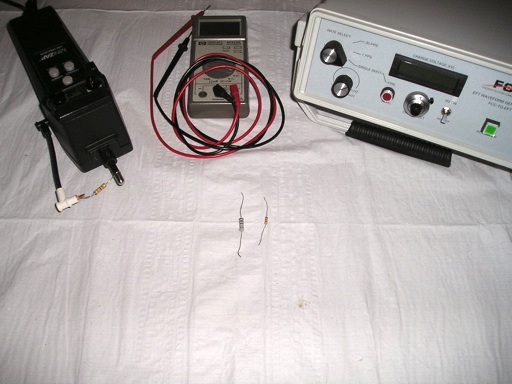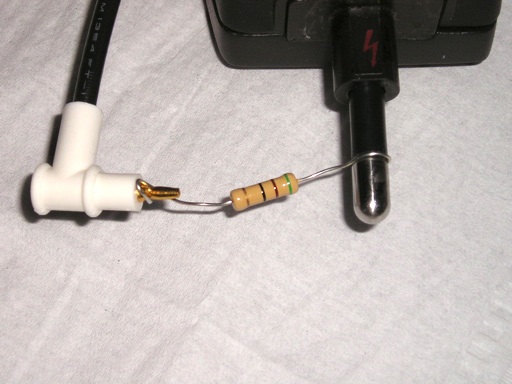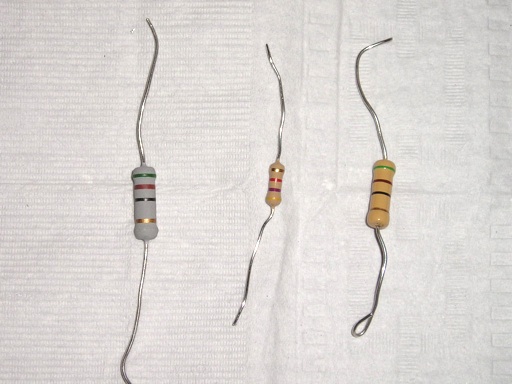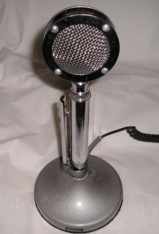
Figure 1. Test Setup Including Mini-Zap ESD Simulator and TG-EFT High Voltage Pulse Generator
Abstract: Carbon composition
resistors work very well under pulsed conditions, but are getting
difficult to obtain. Results of tests run on several modern film
resistors using high voltage pulses are presented. For the cases
tested, the resistors performed well with no damage.
Discussion: Figure 1
shows the test setup. High voltage pulses with a duration of about 100
ns were applied from a Mini-Zap ESD simulator in contact discharge mode
and a Fischer Custom Communications TG-EFT high voltage pulse
generator. The TG-EFT waveform simulates electrical fast transients,
EFT, found on power lines. The wave shape is similar to ESD but without
the leading peak.
Carbon composition resistors are the resistors of choice for pulsed applications but are becoming difficult to find, especially in electronic stores. I need a supply of resistors that will not be damaged by ESD or EFT waveforms so I decided to test several resistors from a local electronic store.
Several metal and carbon film resistors ranging in value from 51 Ohms (one Watt) to 4700 Ohms (1/2 Watt) were tested. Figure 2 shows a 51 Ohm 1 Watt Carbon Film resistor connected to the Mini-Zap for testing. Also tested were a 51 Ohm 1 Watt metal film resistor, 470 Ohm 1/2 Watt "film" resistor, a 1000 Ohm 1/2 Watt "film" resistor, and 4700 Ohm 1/2 Watt "film" resistor. The TG-EFT generator was used up to 2000 Volts followed by the Mini-Zap at 10,000 Volts.

Figure 2. 51 Ohm Film Resistor Stressed by ESD Simulator
Figure 3 shows three of the resistors tested including a 51 Ohm 1 Watt Metal Film Resistor, a 4700 Ohm 1/2 Watt "Film" Resistor, and a 51 Ohm 1 Watt Carbon Film Resistor. The 51 Ohm resistors carry more peak current from the Mini-Zap or TG-EFT, but the 4700 Ohm resistor sees more voltage stress. It was not clear before the testing started which ones would be more susceptible to damage. In the past, I have been able to destroy 1 megohm resistors used in ESD control by using an ESD simulator set to voltages on the order of 10 kV.

Surprisingly enough, all the resistors survived many tens of pulses with no change in resistance as measured on an accurate digital multimeter capable of detecting a change of 1 Ohm out of 1000 Ohms. This is likely due to the fact that these were all 5% resistors and as such were not likely laser trimmed. Laser trimmed 1% resistors often do not survive high peak value pulses because the current concentrates around the end of the laser cut and the resistance exhibits a cumulative change over many pulses often ending in an open circuit or occasionally even a short circuit. The result would also have likely been different if simulated 6 kV lightning pulses were used as these pulses are measured in tens and hundreds of microseconds. Longer length pulses, such as lightning pulses, are much more likely to damage resistors.
Carbon composition resistors are the resistors of choice for pulsed applications but are becoming difficult to find, especially in electronic stores. I need a supply of resistors that will not be damaged by ESD or EFT waveforms so I decided to test several resistors from a local electronic store.
Several metal and carbon film resistors ranging in value from 51 Ohms (one Watt) to 4700 Ohms (1/2 Watt) were tested. Figure 2 shows a 51 Ohm 1 Watt Carbon Film resistor connected to the Mini-Zap for testing. Also tested were a 51 Ohm 1 Watt metal film resistor, 470 Ohm 1/2 Watt "film" resistor, a 1000 Ohm 1/2 Watt "film" resistor, and 4700 Ohm 1/2 Watt "film" resistor. The TG-EFT generator was used up to 2000 Volts followed by the Mini-Zap at 10,000 Volts.

Figure 2. 51 Ohm Film Resistor Stressed by ESD Simulator
Figure 3 shows three of the resistors tested including a 51 Ohm 1 Watt Metal Film Resistor, a 4700 Ohm 1/2 Watt "Film" Resistor, and a 51 Ohm 1 Watt Carbon Film Resistor. The 51 Ohm resistors carry more peak current from the Mini-Zap or TG-EFT, but the 4700 Ohm resistor sees more voltage stress. It was not clear before the testing started which ones would be more susceptible to damage. In the past, I have been able to destroy 1 megohm resistors used in ESD control by using an ESD simulator set to voltages on the order of 10 kV.

Figure 3. Test Resistors
(from left to right: 1W-51 Ohm Metal Film Resistor, 1/2W-4700 Ohm "Film" Resistor, and 1W-51 Ohm Carbon Film Resistor)
(from left to right: 1W-51 Ohm Metal Film Resistor, 1/2W-4700 Ohm "Film" Resistor, and 1W-51 Ohm Carbon Film Resistor)
Surprisingly enough, all the resistors survived many tens of pulses with no change in resistance as measured on an accurate digital multimeter capable of detecting a change of 1 Ohm out of 1000 Ohms. This is likely due to the fact that these were all 5% resistors and as such were not likely laser trimmed. Laser trimmed 1% resistors often do not survive high peak value pulses because the current concentrates around the end of the laser cut and the resistance exhibits a cumulative change over many pulses often ending in an open circuit or occasionally even a short circuit. The result would also have likely been different if simulated 6 kV lightning pulses were used as these pulses are measured in tens and hundreds of microseconds. Longer length pulses, such as lightning pulses, are much more likely to damage resistors.
Summary:All
of the resistors tested survived many tens of pulses at 10,000 Volts
from a Mini-Zap ESD Simulator. This suggests that modern film resistors
in values up to 4700 Ohms and power levels as low as 1/2 Watt that are
not laser trimmed are suitable for use in applications where they are
exposed to ESD and EFT stresses. To be safe, you should check any
resistors you plan to use this way with an ESD simulator as common
resistors are not specified for such use.
Additional articles on this website related to this topic are:
Equipment related to this Technical Tidbit:
- Thermo Scientific Mini-Zap ESD Simulator
- Fischer Custom Communications TG-EFT high voltage pulse generator
Click here for a description of my latest seminar titled (now also available online as a WebEx seminar):
EMC
Lab Techniques for Designers
(How to find EMC problems and have some confidence your system will pass EMC testing while it is still in your lab).
(How to find EMC problems and have some confidence your system will pass EMC testing while it is still in your lab).
 |
My new website for engineers and technicians, CircuitAdvisor.com, is coming! The site will contain technews and analysis programs, cartoons, multimedia tutorials and more.The site will be open soon. |
Home
